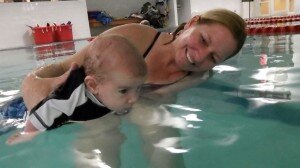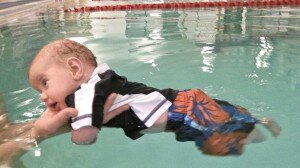#1 Kai (10 weeks old) and Tips for the Tub


How could I talk about drowning prevention and the importance of water safety without starting from the beginning? Thursday morning, I had the pleasure of introducing Kai to the pool for the very first time. He was amazing! You should have seen him cruising around, holding his head up, and putting his face in the water! Check out the videos of Kai putting his face in the water- soon to come on Facebook. (PS- Please be patient with my photos and videos- I'm learning!)
Tub Time Tips
I see a lot of parents protecting their child's face from the water. They put his head back, hold a towel over his eyes and even buy special bath visors. Please, DO NOT do this. The longer you do this, the longer it will take to teach your child to swim. Here are some tips for the bathtub. And remember, I didn't get to swim with Kai until he was 10 weeks old- you can do this as soon as the umbilical cord falls off.
1. Safety: I can't stress the importance of safety enough. Turn off your phone. When you are anywhere near water, do not attempt to multi-task or leave your child unattended. According to the U.S. Consumer Product Safety Commission, a child can drown in the time it takes to answer the phone.
2. Preparing the bath: Fill the tub with 2 to 4 inches of warm water. Babies can drown in less than an inch of water, so take care in how much you use. Be aware that most water heaters are preset at 140 degrees Fahrenheit, which can cause third-degree burns on a baby's sensitive skin. Set your water heater to only 120 degrees Fahrenheit to prevent accidental scalding. While filling the tub, prepare the area- make sure you have a towel, any tub toys and a cup within reach. If you can, make sure the air temperature is warm as well. Before putting your baby in the tub, be sure to move the water around and check the temperature with your elbow or the back of your hand.
3. In the bath: Hold the baby at all times so he doesn't slip, fall over or accidentally submerge. When taking him in and out of the tub, use one arm to support his head, neck and torso. The other arm should be used to support his bum and legs.
4. Getting the baby's face wet: Fill the cup with water and slowly pour it on his hands and arms using the cue, “One, Two, Ready, Swim." Move to the shoulders and torso, again using the cue, "One, Two, Ready, Swim." Use the same cue every time. Continue to the back, then the top of the head. Allow water to slowly run down his face and show him how you blink your eyes to get the water out. Work on developing all five of his senses as he begins to build a healthy relationship with the water. This should start out as a very gentle, calming experience.
When water is poured on this head, he may flail his arms, kick his legs and hold his breath (as he did in the womb). It's okay- Don't freak out. He is born with "swimming" reflexes! Instead of reaching for a towel, continue gently cueing and pouring. Make it a ritual and use the same routine to bathe your child every time.

